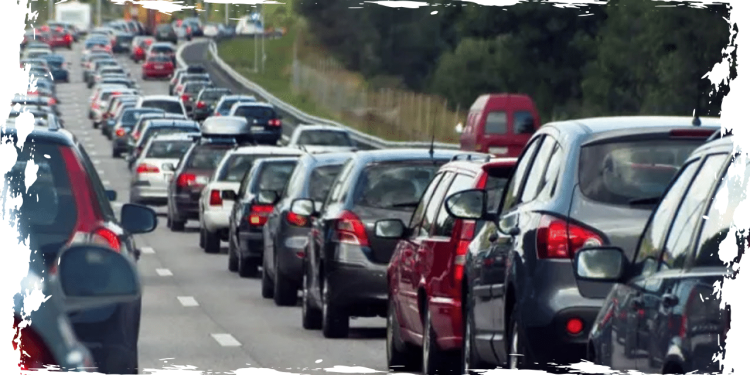According to a recent study from the Texas A&M Transportation Institute, the days of light traffic on the roads during the pandemic are now a thing of the past.
According to David Schrank, a senior research scientist and primary author of the Institute’s Urban Mobility Report, the majority of the country has returned to the same levels of congestion and traffic delays seen before the COVID-19 pandemic. Surprisingly, in some cities, traffic conditions have worsened despite having fewer total commuters on the road when compared to 2019.
According to Schrank, the commute has become less predictable due to the increasing number of hybrid work schedules. It has become difficult to anticipate when colleagues in the same area will be summoned to the office for significant presentations or all-hands meetings.
Schrank warned that the unpredictability of returning to the office could lead to gridlock on the roads. He explained that if everyone suddenly returns to the office on the same day, it could cause chaos and traffic jams. “On any given day, everybody might be going into the office and no one is expecting it. What if next Monday everybody gets called in? Then boom – it’s gridlock,” he said.
According to him, early data suggests that Monday is the least favored day for employees to commute to work.
With the rise of flexible work schedules, commuting has become even more time-consuming. Many office workers now choose to work from home in the morning and then head to the office around 10 a.m. or leave early at 3 p.m. to avoid the rush. However, this has inadvertently led to a shift in the rush hour traffic, causing delays to creep later into the morning and earlier into the afternoon.
With the pandemic forcing people to prioritize space, many have relocated to the suburbs and exurbs, resulting in longer commutes now that they are back in the office. This has led to an increase in traffic delays in cities such as Phoenix, which have experienced a significant surge in population growth.
According to the researchers, there is another significant reason behind the worsening traffic delays, and it’s not related to the return of the daily office commute. In an effort to mitigate the supply chain issues that emerged in 2020 and to enhance shipping efficiency for the increasing number of online orders, major retailers, including Amazon, have established additional warehouses across the nation.
Trucks are the primary mode of transportation for delivering products from mega-warehouses to your doorstep or local store. However, with the ongoing pandemic, truck congestion has become a more significant issue than ever before.
Truck drivers are constantly on the move, navigating through major highways at any given time. Their presence on the road adds to the already existing traffic congestion, which is not limited to just regular rush hour periods.
Many cities that experienced worse traffic problems in 2022 compared to pre-pandemic times are located at the intersections of major interstates.
According to Schrank, cities like Columbus, Louisville, and Nashville are major corridors due to the presence of interstates such as I-75, connecting cities like Atlanta and Chicago. The increase in traffic in these areas can be attributed to the rise in commercial traffic and trucking.
According to Schrank, cities with ports like Los Angeles, Chicago, and New York have experienced a faster rebound in traffic following the COVID-19 pandemic. This is partly due to an increase in commercial traffic in these areas.
According to Schrank, your perception of a deteriorating commute experience may depend on the specific conditions of your daily route. The number of individuals who are forced to take the same path as you and the exact corridor you need to travel on can play a significant role in this perception.
The Texas A&M Transportation Institute discovered that the top 20 metropolitan areas by percentage experienced the most significant increase in total yearly delay between 2019 and 2022.
-
- Rochester, New York (10% worse)
- Bakersfield, California (10% worse)
- Laredo, Texas (10% worse)
- Provo, Utah (9% worse)
- Louisville, Kentucky (8% worse)
- Milwaukee, Wisconsin (8% worse)
- Bridgeport-Stamford, Connecticut (8% worse)
- New Haven, Connecticut (8% worse)
- Little Rock, Arkansas (8% worse)
- Oklahoma City, Oklahoma (7% worse)
- Riverside-San Bernardino, California (7% worse)
- Salt Lake City, Utah (7% worse)
- Phoenix-Mesa, Arizona (6% worse)
- Baton Rouge, Louisiana (6% worse)
- Colorado Springs, Colorado (6% worse)
- Stockton, California (6% worse)
- Charleston-North Charleston, South Carolina (5% worse)
- Omaha, Nebraska (5% worse)
- Sacramento, California (4% worse)
- Memphis, Tennessee (4% worse)
In contrast, certain major cities are still observing significantly reduced traffic compared to the pre-pandemic era. For instance, Washington, D.C. witnessed a decline of 26% in overall delays, while Boston experienced a reduction of 21%.
Despite the impact of COVID-19 on transportation, several cities, including San Francisco, Dallas, and Portland, Oregon, have observed only a slight decrease in traffic. The reduction is typically around 2% to 3%, which is negligible for most drivers while driving on the roads.
Read More:
- Why Aren’t Guardrails Installed on Dangerous Mountain Roads?
- Heart Disease Identified as the Cause of Death for Former NBA Player Darius Morris, with Drugs and Alcohol as Contributing Factors


